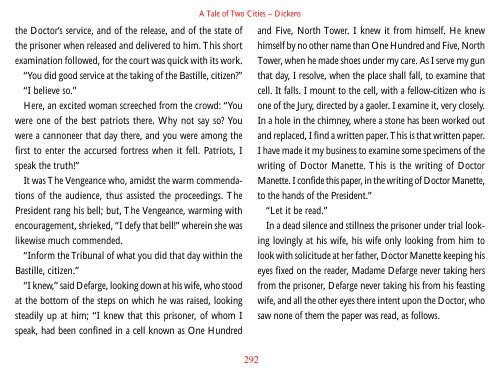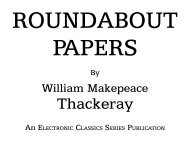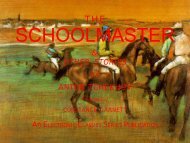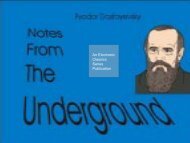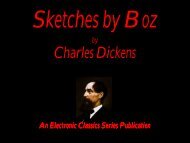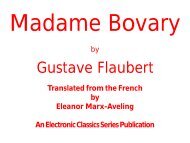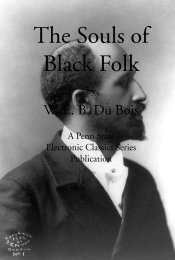A Tale of Two Cities by Charles Dickens - Penn State University
A Tale of Two Cities by Charles Dickens - Penn State University
A Tale of Two Cities by Charles Dickens - Penn State University
You also want an ePaper? Increase the reach of your titles
YUMPU automatically turns print PDFs into web optimized ePapers that Google loves.
A <strong>Tale</strong> <strong>of</strong> <strong>Two</strong> <strong>Cities</strong> – <strong>Dickens</strong><br />
the Doctor’s service, and <strong>of</strong> the release, and <strong>of</strong> the state <strong>of</strong><br />
the prisoner when released and delivered to him. This short<br />
examination followed, for the court was quick with its work.<br />
“You did good service at the taking <strong>of</strong> the Bastille, citizen”<br />
“I believe so.”<br />
Here, an excited woman screeched from the crowd: “You<br />
were one <strong>of</strong> the best patriots there. Why not say so You<br />
were a cannoneer that day there, and you were among the<br />
first to enter the accursed fortress when it fell. Patriots, I<br />
speak the truth!”<br />
It was The Vengeance who, amidst the warm commendations<br />
<strong>of</strong> the audience, thus assisted the proceedings. The<br />
President rang his bell; but, The Vengeance, warming with<br />
encouragement, shrieked, “I defy that bell!” wherein she was<br />
likewise much commended.<br />
“Inform the Tribunal <strong>of</strong> what you did that day within the<br />
Bastille, citizen.”<br />
“I knew,” said Defarge, looking down at his wife, who stood<br />
at the bottom <strong>of</strong> the steps on which he was raised, looking<br />
steadily up at him; “I knew that this prisoner, <strong>of</strong> whom I<br />
speak, had been confined in a cell known as One Hundred<br />
and Five, North Tower. I knew it from himself. He knew<br />
himself <strong>by</strong> no other name than One Hundred and Five, North<br />
Tower, when he made shoes under my care. As I serve my gun<br />
that day, I resolve, when the place shall fall, to examine that<br />
cell. It falls. I mount to the cell, with a fellow-citizen who is<br />
one <strong>of</strong> the Jury, directed <strong>by</strong> a gaoler. I examine it, very closely.<br />
In a hole in the chimney, where a stone has been worked out<br />
and replaced, I find a written paper. This is that written paper.<br />
I have made it my business to examine some specimens <strong>of</strong> the<br />
writing <strong>of</strong> Doctor Manette. This is the writing <strong>of</strong> Doctor<br />
Manette. I confide this paper, in the writing <strong>of</strong> Doctor Manette,<br />
to the hands <strong>of</strong> the President.”<br />
“Let it be read.”<br />
In a dead silence and stillness the prisoner under trial looking<br />
lovingly at his wife, his wife only looking from him to<br />
look with solicitude at her father, Doctor Manette keeping his<br />
eyes fixed on the reader, Madame Defarge never taking hers<br />
from the prisoner, Defarge never taking his from his feasting<br />
wife, and all the other eyes there intent upon the Doctor, who<br />
saw none <strong>of</strong> them the paper was read, as follows.<br />
292


